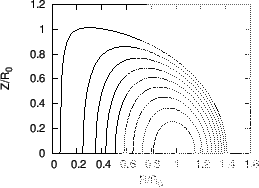For most choices of  and
and  , the GS equation has to be
solved numerically. For the particular choice of
, the GS equation has to be
solved numerically. For the particular choice of  and
and  profiles,
profiles,
 |
(69) |
 |
(70) |
analytical solution to the GS equation can be found, which is given
by[9]
 |
(71) |
where  ,
,  ,
,  , and
, and  are arbitrary constants. [Proof: By
direct substitution, we can verify
are arbitrary constants. [Proof: By
direct substitution, we can verify  of this form is indeed a solution to
the GS equation (53).] A useful choice for tokamak application is to
set
of this form is indeed a solution to
the GS equation (53).] A useful choice for tokamak application is to
set
 ,
,
 , and
, and  . Then Eq. (71) is written
. Then Eq. (71) is written
![$\displaystyle \Psi = \frac{B_0}{2 R_0^2 \kappa_0 q_0} \left[ R^2 Z^2 + \frac{\kappa_0^2}{4} (R^2 - R_0^2)^2 \right],$](img326.png) |
(72) |
which can be solved analytically to give the explicit form of the contour of
 on
on  plane:
plane:
 |
(73) |
which indicates the magnetic surfaces are up-down symmetrical. Using Eq.
(69), i.e.,
 |
(74) |
the pressure is written
 |
(75) |
where  is a constant of integration. Note Eq. (72) indicates
that that
is a constant of integration. Note Eq. (72) indicates
that that  at the magnetic axis (
at the magnetic axis (
 ). Therefore, Eq.
(75) indicates that
). Therefore, Eq.
(75) indicates that  is the pressure at the magnetic axis. The
toroidal field function
is the pressure at the magnetic axis. The
toroidal field function  is a constant in this case, which implies there is
no poloidal current in this equilibrium. (For the Solovev equilibrium
(72), I found numerically that the value of the safety factor at the
magnetic axis (
is a constant in this case, which implies there is
no poloidal current in this equilibrium. (For the Solovev equilibrium
(72), I found numerically that the value of the safety factor at the
magnetic axis (
 ) is equal to
) is equal to
 . This result
should be able to be proved analytically. I will do this later. In calculating
the safety factor, we also need the expression of
. This result
should be able to be proved analytically. I will do this later. In calculating
the safety factor, we also need the expression of
 , which is
given analytically by
, which is
given analytically by
)
Define
 , and
, and
 , then Eq.
(72) is written as
, then Eq.
(72) is written as
where
 ,
,
 . From Eq.
(77), we obtain
. From Eq.
(77), we obtain
 |
(78) |
Given the value of  ,
,  , for each value of
, for each value of
 , we
can plot a magnetic surface on
, we
can plot a magnetic surface on
 plane. An
example of the nested magnetic surfaces is shown in Fig. 6.
plane. An
example of the nested magnetic surfaces is shown in Fig. 6.
Figure 6:
Flux surfaces of Solovév equilibrium for
 and
and  , with
, with
 varying from zero
(center) to 0.123 (edge). The value of
varying from zero
(center) to 0.123 (edge). The value of
 on the edge is
determined by the requirement that the minimum of
on the edge is
determined by the requirement that the minimum of
 is equal to
zero. (To prevent ``divided by zero'' that appears in Eq. (78)
when
is equal to
zero. (To prevent ``divided by zero'' that appears in Eq. (78)
when  , the value of
, the value of
 on the edge is shifted to
on the edge is shifted to
 when plotting the above figure, where
when plotting the above figure, where
 is
a small number,
is
a small number,
 in this case.)
in this case.)
 |
The minor radius of a magnetic surface of the Solovev equilibrium can be
calculated by using Eq. (73), which gives
 |
(79) |
 |
(80) |
and thus
 |
(81) |
where
 . In my code of constructing Solovev
magnetic surface, the value of
. In my code of constructing Solovev
magnetic surface, the value of  is specified by users, and then Eq.
(81) is solved numerically to obtain the value of
is specified by users, and then Eq.
(81) is solved numerically to obtain the value of  of the flux
surface. Note that the case
of the flux
surface. Note that the case  corresponds to
corresponds to
 , i.e., the magnetic axis, while the case
, i.e., the magnetic axis, while the case
 corresponds to
corresponds to
 . Therefore, the
reasonable value of
. Therefore, the
reasonable value of  of a magnetic surface should be in the range
of a magnetic surface should be in the range
 . This range is used as the
interval bracketing a root in the bisection root finder.
. This range is used as the
interval bracketing a root in the bisection root finder.
Using Eq. (81), the inverse aspect ratio of a magnetic surface
labeled by  can be approximated as[9]
can be approximated as[9]
 |
(82) |
Therefore, the value of  of a magnetic surface with the inverse aspect
ratio
of a magnetic surface with the inverse aspect
ratio
 is approximately given by
is approximately given by
 |
(83) |
yj
2018-03-09
![]() and
and ![]() , the GS equation has to be
solved numerically. For the particular choice of
, the GS equation has to be
solved numerically. For the particular choice of ![]() and
and ![]() profiles,
profiles,


![$\displaystyle \frac{B_0}{2 R_0^2 \kappa_0 q_0} \sqrt{[2 R Z^2 + \kappa_0^2 (R^2 -
R_0^2) R]^2 + (2 R^2 Z)^2} .$](img335.png)
![]() , and
, and
![]() , then Eq.
(72) is written as
, then Eq.
(72) is written as



![]() can be approximated as[9]
can be approximated as[9]

